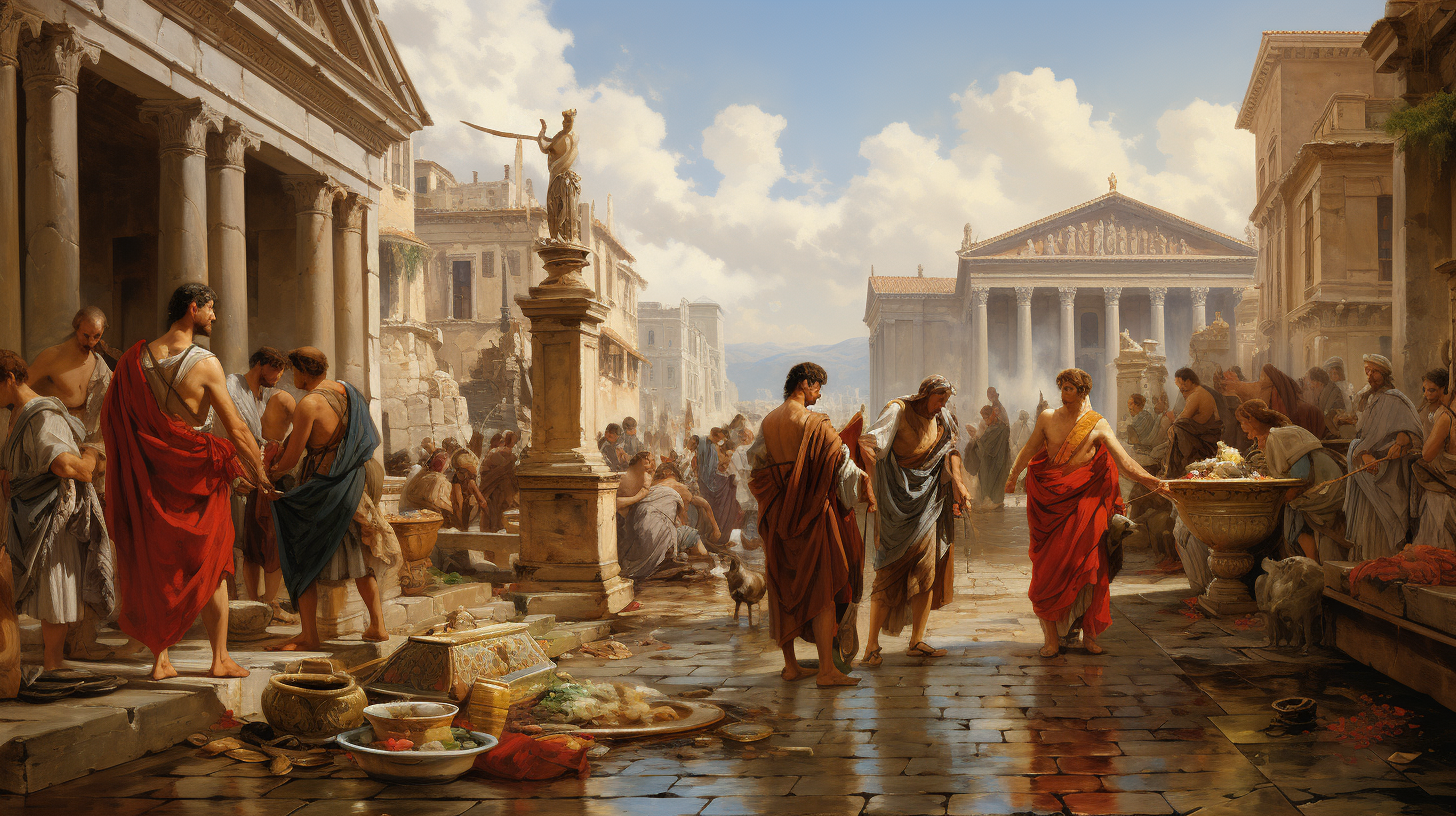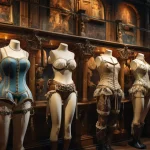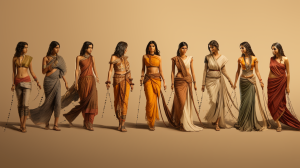
🌟 Unveiling Roman Splendor: A Fashion Journey Through Time 🌟
Exploring the Mysteries of Roman Attire
Welcome to Fashion Time Warp, where we embark on a captivating journey through the annals of fashion history. Today, our digital time machine whisks us away to the grandeur of ancient Rome, a civilization that left an indelible mark on the world, not only through its conquests and innovations but also through its captivating sense of style. Join us as we delve deep into the heart of Roman fashion, where the toga and tunic take center stage, and where every garment tells a story of a bygone era.
🏛️ Step into the grandeur of ancient Rome, where the echoes of emperors and gladiators still resonate in the remnants of ancient ruins. As we journey through this captivating empire, we’ll decode the significance of the toga and tunic, uncovering their roles as more than just garments but as symbols of citizenship, prestige, and everyday life. These pieces of fabric, meticulously draped and tailored, held a mirror to Roman society, reflecting its values, culture, and aspirations.
🏛️ A Glimpse into Ancient Rome
Welcome to the heart of ancient Rome, a civilization that once spanned vast territories, from the majestic city itself to the far reaches of its empire. In this section, we’ll journey through the annals of Roman history, exploring the historical context and societal significance that laid the foundation for Roman fashion.
🌍 Historical Context: Rome’s Magnificent Rise
The story of Roman fashion begins with the rise of the Roman Republic, around 509 BCE. At this time, Rome was a fledgling city-state, but it would soon grow into an empire of unmatched power and influence. The historical context of Rome’s expansion, from the early Republic to the later days of the Empire, shaped not only its political destiny but also its sense of fashion.
Placeholder Image: Imagine a sprawling Roman cityscape, with grand architecture, bustling markets, and people dressed in various styles of togas and tunics, going about their daily lives.
🏛️ Fashion as a Reflection of Society
In the heart of ancient Rome, clothing was more than just a necessity; it was a statement of identity and societal role. Romans, like us today, used clothing to communicate their status, values, and aspirations. Understanding this connection between fashion and society is key to unlocking the secrets of Roman attire.
👑 The Role of the Toga: Symbol of Citizenship and Prestige
The toga, one of the most iconic garments in Roman history, served as a powerful symbol of Roman citizenship and prestige. It was more than a piece of clothing; it was a badge of honor. Citizens wore togas with pride, and the style and quality of the toga reflected one’s social standing.
👕 The Tunic: Everyday Attire for All
Contrastingly, the tunic was the everyday attire of Romans, worn by people of all social classes. Its simplicity and functionality made it a practical choice for the rigors of daily life. However, the tunic was far from plain; it came in various styles and lengths, each serving a specific purpose.
Placeholder Image: Picture a Roman marketplace filled with diverse individuals, from senators in their distinguished togas to commoners donning comfortable tunics, illustrating the range of Roman attire.
⚖️ Dress Codes and Social Norms
To navigate the complexities of Roman society, one had to adhere to strict dress codes and societal norms. We’ll explore how these norms dictated what Romans wore on different occasions, from formal events to the mundane tasks of daily life.
🌟 Setting the Stage for Fashion Evolution
As we delve deeper into the world of Roman attire, keep in mind the significance of this historical context and the role it played in shaping the fashion landscape of ancient Rome. Our journey has just begun, and the toga and tunic are but the first layers of this rich tapestry of Roman splendor.
🏛️ The Toga: Symbol of Roman Citizenship
In the grand theater of ancient Rome, few garments commanded as much attention and respect as the toga. It was more than a mere piece of fabric; it was a symbol of Roman citizenship and prestige, a garment that bore the weight of history and tradition.
👑 A Cloak of Citizenship: The Toga’s Significance
The toga was not an ordinary garment; it was a privilege bestowed upon Roman citizens. To wear the toga was to declare one’s allegiance to the Republic and the responsibilities that came with it. Its significance went beyond fashion; it was a declaration of identity.
🏛️ Types of Togas: A Spectrum of Status
Within the realm of the toga, there were various styles and types, each conveying a different message about the wearer’s status and role in society. From the pure white toga virilis of youth to the ornate and regal toga picta of emperors, each type of toga had its own purpose.
📜 The Art of Toga Draping: A Skillful Ritual
Wearing a toga was an art form in itself. The draping and folding of the toga were precise, and there were rules and rituals associated with its wearing. Learning to drape a toga properly was a skill passed down through generations, and it was a mark of Roman education and refinement.
👁️ Visual Symbolism: Colors and Accents
The toga wasn’t just a white sheet; it could be adorned with colored borders, known as the “toga praetexta.” These colors held specific meanings and were often used to distinguish individuals of different ranks or roles. The toga itself was a canvas upon which one’s identity was painted.
🏛️ The End of an Era: Decline in Toga Wearing
As we journey through the annals of Roman fashion, we’ll explore how the toga gradually fell out of favor in favor of more practical and comfortable attire. The decline of the toga marked not just a shift in fashion but also changes in the political and social landscape of Rome.
Placeholder Image: Visualize an exquisite marble statue of a Roman citizen, elegantly draped in a toga, standing proudly in the heart of ancient Rome, epitomizing the elegance and prestige associated with this iconic garment.
👕 The Tunic: Everyday Attire for All
While the toga held a place of prominence in Roman society, it was the humble tunic that truly embodied the essence of everyday life in ancient Rome. Versatile, practical, and worn by individuals of all social classes, the tunic was the unifying thread that connected Romans from all walks of life.
🏛️ A Garment for the Masses: The Tunic’s Universality
Unlike the toga, which was reserved for Roman citizens, the tunic was the attire of choice for virtually everyone in Rome. From senators to soldiers, men, women, and children, the tunic was a common sight on the streets of the eternal city.
👕 Variations in Style: Tunics for Every Occasion
The simplicity of the tunic did not mean uniformity. In fact, there was a remarkable diversity in tunic styles, and the choice of tunic often depended on factors such as social status, gender, age, and the occasion. From the knee-length tunica talaris to the sleeveless tunica recta, there was a tunic for every purpose.
🏛️ Practicality Meets Fashion: The Tunic’s Design
The design of the tunic was as practical as it was fashionable. Its loose, comfortable fit allowed for ease of movement, ideal for the bustling streets of Rome. However, the tunic was not without style, and it often featured decorative elements, such as colorful borders and embellishments.
👑 Gender Distinctions: Tunics for Men and Women
In the world of Roman fashion, there were distinct differences in the way men and women wore their tunics. We’ll explore these gender distinctions, shedding light on how the tunic was adapted to suit the needs and expectations of both sexes.
Placeholder Image: Imagine a Roman family scene, where men, women, and children are dressed in various styles of tunics, showcasing the diversity of this everyday attire.
🏛️ Beyond Rome: The Tunic’s Influence
As we continue our fashion journey, we’ll see how the tunic transcended the boundaries of Rome, influencing clothing styles in neighboring regions and even leaving a lasting mark on contemporary fashion.
🌟 The Tunic: A Thread of Unity
The tunic, in all its variations, was not just a garment but a symbol of unity in diversity. It was a reflection of the Roman ethos that celebrated the practicality and versatility of everyday life. As we move forward in our exploration of Roman fashion, let’s carry the essence of the tunic with us—a reminder that fashion is not just about grand ceremonies but also about the tapestry of everyday existence.
🎨 Fabrics and Colors in Roman Clothing
In the vibrant world of Roman attire, fabrics and colors played a pivotal role in shaping not only the look of garments but also the messages they conveyed. Join us as we unravel the rich tapestry of fabrics and hues that adorned the toga and tunic in ancient Rome.
🏛️ Textiles of Choice: From Wool to Silk
Roman clothing was a testament to the craftsmanship of the time, with fabrics carefully chosen to suit various purposes. Wool, being readily available, was the most common material for clothing. However, we’ll also explore the luxury of silk and the significance of textiles in differentiating social classes.
🌈 The Language of Colors: Meaning and Symbolism
Colors held deep significance in Roman clothing. From the pure white of the toga to the vibrant hues of the tunic’s borders, each color told a story. We’ll delve into the meanings behind these colors and how they were used to convey messages of identity, status, and even political affiliation.
🌟 Adornments and Embellishments: Fabric Decorations
Roman garments were not plain and unadorned. They were often embellished with decorative elements, showcasing the creativity and artistry of the time. We’ll explore the intricate details of these adornments, from intricate embroidery to intricate borders.
Placeholder Image: Imagine a close-up view of a toga’s border, adorned with exquisite embroidery and vibrant colors, exemplifying the artistry and attention to detail in Roman clothing.
🏛️ Dyeing Techniques: Mastering the Art of Color
The process of dyeing fabrics was an art form in ancient Rome. Skilled dyers created a wide range of colors using natural ingredients. We’ll uncover the techniques behind the creation of these colors and their role in shaping Roman fashion.
🌍 Influences Beyond Rome: A Global Palette
Roman fashion didn’t exist in isolation; it was influenced by and influenced neighboring cultures. We’ll explore how Roman textiles and colors left their mark on the fashion of the Mediterranean world and beyond.
🌟 Fabric and Color: A Thread of Culture
As we continue our journey through the annals of Roman fashion, let’s appreciate the role that fabrics and colors played in shaping not only the aesthetics but also the cultural significance of clothing. These elements wove together a tapestry of identity and expression in the grandeur of ancient Rome.
👗 Dressing for Different Occasions
In the bustling streets of ancient Rome, clothing was not just a matter of personal style; it was a statement of one’s role in society and the occasion at hand. Join us as we explore how Romans dressed for various events and how clothing choices were a window into their world.
🏛️ The Toga: Elegance for Formal Affairs
Formal events in ancient Rome demanded the grandeur of the toga. We’ll dive into the world of elegant drapery and the various styles of togas reserved for special occasions, from the toga praetexta for young boys to the toga pura for adult citizens.
👕 The Tunic: Everyday Practicality
While the toga was ideal for formal gatherings, the tunic was the go-to attire for daily life. Discover how the tunic’s comfort and versatility made it the perfect choice for tasks as mundane as going to the market or engaging in trade.
Placeholder Image: Envision a Roman forum bustling with activity, where individuals are dressed in a stunning array of togas for formal occasions and tunics for their everyday pursuits, showcasing the diversity of Roman attire.
🏛️ Military Dress: The Uniforms of Roman Soldiers
In the world of the Roman military, attire was not only functional but also symbolic of honor and allegiance. We’ll explore the distinctive uniforms worn by Roman soldiers, including the iconic lorica segmentata and the prestigious paludamentum.
👑 Ceremonial Attire: A Glimpse into Imperial Fashion
As we journey through Roman fashion history, we’ll unveil the opulence of ceremonial attire worn by emperors and high-ranking officials. The toga picta, worn during triumphal processions, was a dazzling display of luxury and power.
🏛️ Religious Rituals: Garments of the Priesthood
Religion played a central role in Roman society, and the attire of priests and priestesses was imbued with spiritual significance. We’ll delve into the symbolism and attire associated with religious ceremonies.
🌟 Attire as a Language: Communicating Identity
From formal events to religious rituals, attire was a language that conveyed one’s identity, social standing, and role in society. As we explore how Romans dressed for different occasions, let’s decipher the messages woven into the fabric of their clothing.
👫 Gender Distinctions: Tunics for Men and Women
In the intricate world of Roman attire, gender played a significant role in shaping clothing choices. Join us as we explore how Roman men and women expressed their identity through the design and styling of their tunics.
🚹 The Roman Tunic: Men’s Attire
For Roman men, the tunic was not just a garment but a symbol of their societal roles. We’ll delve into the nuances of men’s tunics, from their styles to the ways in which they were worn. The tunic was a canvas upon which men painted their social status.
🚺 Women’s Tunic: Elegance and Modesty
Roman women, too, had a distinct style of tunic that reflected their femininity and societal expectations. We’ll uncover the variations in women’s tunics, exploring how they balanced practicality with the need for modesty.
Placeholder Image: Visualize a Roman courtyard, where men and women are engaged in daily life, their clothing reflecting the gender-specific designs and styles of Roman tunics.
🌟 Beyond the Basics: Accessories and Adornments
While tunics were the foundation of Roman clothing, accessories and embellishments added flair and personality to each ensemble. We’ll explore how men and women adorned themselves, from belts and jewelry to hairstyles.
🏛️ Clothing and Identity: Conveying Social Roles
In the grand tapestry of Roman society, clothing was a powerful tool for conveying social roles and distinctions. We’ll delve into how Roman men and women used their attire to communicate their place in the social hierarchy.
🌟 Evolution of Gendered Attire: Changing Trends
As we journey through Roman fashion history, we’ll see how gendered attire evolved over time, reflecting shifts in societal norms and influences from neighboring cultures. The story of Roman fashion is one of constant adaptation and change.
🌟 The Language of Tunics: A Reflection of Identity
In the world of Roman fashion, tunics were more than just garments; they were a reflection of identity. As we conclude our exploration of gender distinctions in Roman attire, let’s appreciate how these tunics were woven into the fabric of Roman society, telling a story of roles, expectations, and individuality.
🌍 Influences Beyond Rome: A Global Palette
As we journey through the captivating world of Roman fashion, it becomes evident that Rome’s influence extended far beyond its borders. Join us as we explore how the Roman fashion palette left a lasting mark on the Mediterranean world and beyond, shaping clothing choices in neighboring cultures.
🌄 Roman Fashion in the Mediterranean: A Cultural Exchange
The Roman Empire’s expansive reach facilitated cultural exchanges, including fashion. We’ll uncover how Roman attire influenced clothing styles in regions such as Greece, Egypt, and North Africa, resulting in a fascinating blend of cultures.
👘 Tunics and Togas Abroad: The Roman Impact
The tunics and togas of Rome found their way into the wardrobes of people in conquered lands. We’ll examine how these Roman garments were adapted and incorporated into the daily lives of individuals in different regions.
Placeholder Image: Imagine a bustling marketplace in a Mediterranean city, where people from diverse backgrounds are dressed in a fusion of Roman-inspired attire, showcasing the cross-cultural influence of Roman fashion.
🗺️ Roman Trade Routes: A Path for Fashion Exchange
Roman trade routes served as conduits not only for goods but also for fashion. We’ll delve into how the Silk Road and other trade networks facilitated the flow of textiles, colors, and clothing styles, creating a global fashion tapestry.
🌟 Legacy of Roman Fashion: An Enduring Influence
The legacy of Roman fashion continues to echo in contemporary attire. We’ll explore how elements of Roman clothing, such as the toga-inspired academic regalia and tunic-inspired modern casual wear, still shape the way we dress today.
🌎 Beyond Rome: A World of Fashion
As we conclude our exploration of Roman fashion’s global impact, let’s appreciate how clothing choices transcended boundaries, fostering a sense of interconnectedness in the diverse cultures that adorned themselves in the threads of Rome’s influence.
🌟 Unraveling the Threads of Roman Fashion
As our enthralling journey through the annals of Roman fashion comes to a close, let us take a moment to reflect on the rich tapestry we’ve explored together. Roman attire was not merely clothing; it was a canvas that painted a vivid portrait of an empire’s identity, culture, and evolution.
🏛️ Threads of Tradition: Roman Attire’s Deep Roots
Roman clothing, rooted in tradition and history, was a reflection of the society it adorned. From the solemn toga worn by senators to the everyday tunic of a commoner, each garment carried its own tale.
🌈 A Spectrum of Styles: From Togas to Tunics
We’ve journeyed through the elegant folds of the toga and the practicality of the tunic, witnessing the versatility and symbolism that Roman fashion offered. The Roman wardrobe was a symphony of colors, textures, and meanings.
Placeholder Image: Picture a mosaic depicting a bustling Roman street, where individuals from various walks of life are attired in a spectrum of Roman clothing, capturing the essence of diversity in fashion.
🌍 An Empire’s Influence: Rome’s Global Fashion Legacy
Our exploration extended beyond Rome’s borders, unveiling how Roman attire influenced and intertwined with cultures around the Mediterranean and beyond. The echoes of Roman fashion continue to resonate in contemporary clothing.
🌟 Threads of Continuity: Lessons from Roman Fashion
As we conclude our captivating journey, let’s carry with us the lessons of Roman fashion. Clothing is not just a means of covering the body but a language that communicates identity, history, and culture. It is a thread that weaves together the stories of individuals and civilizations.
💬 Join the Conversation
Thank you for joining us on this enlightening odyssey through the annals of Roman fashion. We hope this exploration has deepened your appreciation for the significance of clothing in history and culture. Feel free to share your thoughts, questions, and reflections in the comments below. Let the conversation continue as we celebrate the enduring influence of Roman fashion on the world stage.








